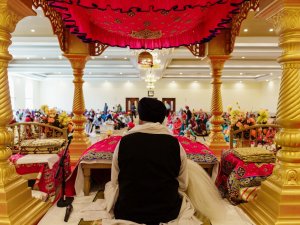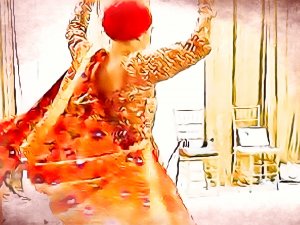You may remember the spoken word poet, Sukhjit Kaur Khalsa from Australia’s Got Talent where she defended the Sikh identity, stood up for Sikh women’s rights, and embraced her fiercely Kaur lifestyle. In this piece, she shares her journey of new-found fame and reveals the double-standards, inequality, criticism, and bigotry she faced from the Sikh community. Warning: this article contains explicit language.
As I write this, it’s the last day of 2016 and I think this is an appropriate time for me to finally reflect on how this year was probably the biggest year of my life. I feel like after I went on Australia’s Got Talent (AGT), I experienced what 1% of Beyoncé’s life might be. If Beyoncé was Indian. A Kaur. Living in Australia. With no coordination. It’s about time you gain an insight into my D-grade celebrity life.
Before you keyboard warriors freak out and think I’m attacking Sikhi, believe me, I’m not. I’m just going to be giving you an insight to what it’s like being a Sikh girl in 2016 because last time I checked, no one in the community tries to step into our shoes.
Most people assume that a brown, hairy girl going on Aussie television would be prone to getting some hate mail from white misogynistic men but, the reality is I get hate from the very men I write my poetry for. I get hate mail from Sikh men. I write about and fight for the the Sikh identity. I fight for the kesh, the beard, and the dastar, which are predominately (but not exclusively) masculine features of Sikhi. I fight for this identity when I travel all over the nation and world performing/speaking at music festivals, schools, conferences, workshops, universities, and even on the street challenging my audiences to look beyond the external; To check ourselves when we judge others based on fear led messages in the media. The irony is, those whom I’m defending are the very ones who harshly berate me.
Let’s start at the beginning. What’s the real reason I felt the need to start doing spoken word poetry? What inspired me? I had just started wearing a dastaar because I felt as a Kaur, I wasn’t sure what my identity was meant to be. I however didn’t dramatically change my wardrobe. I still wore my regular gettup in summer and one day I went to the beach wearing this:
At the time I didn’t really think anything of it. I was feeling the heat of summer. It was a practical outfit and I felt good wearing it. I uploaded the photo to Instagram with a #leghairdontcare.
The same night I was performing as an extra in A Midsummer Night’s Dream for the Perth International Arts Festival. I was backstage about to go on stage when I received a surprising message from a fellow Kaur. She and her husband were concerned that I wasn’t dressed like a “Singhni.” (Personally I don’t really care for that word. I find it to be derogatory, but that’s for another article). “What would Guru Gobind Singh Ji say if he saw me in this attire?” they asked. I thought, “If our Gurus and Waheguru are everywhere and within us all, don’t they ‘see’ me when I’m in the shower and naked like every day?” They continued, “I think you’re spreading the wrong message for young Kaurs.” I thought, “A message that you can embrace your body hair in Aussie heat on a beach?”
My mind was blown. I had no idea that there was such a difference between a Kaur wearing a dastaar and a Singh wearing a dastaar. Had I been living in a bubble believing that Kaurs and Singhs had the same rights?
Don’t give me that crap, “The standards for Sikh men and women are different because we have different bodies and lust etc…” If you truly believe that, then may I suggest you learn more about sociology of gender roles, psychology of attraction, anthropology of culture, human sexuality, and the history of clothing. You also may want to read the Guru Granth Sahib and Sikh Rehat Marayda where I don’t believe shorts are outlawed. Stop perpetuating baseless, sexist arguments to control and dominate women.
- Singhs can go to the beach with whatever clothes they want. Sukhjit posts a picture up with mid-thigh shorts and BOOM the world ends.
- Singhs can be topless with nothing but a kachera on in their front gardens. Kaurs get shamed if they even dare to show some cleavage or wear a tight top.
- Singhs can wear chollas with no pants at the Gurdwara. Kaurs get judged if they wear anything but a sleeved suit at the Gurdwara.
- Singhs can express themselves. Kaurs should behave themselves and face shame for questioning or expressing opinions.
- Singhs can have personalities and be their own person. Kaurs with a dastaar are categorized as “Singhnis” and thus, must not talk to boys, must wear white and be peaceful and pure. Whatever that means.
Don’t give me that crap about my body poisoning the mind of a man. Learn how to control your lust, mate. That’s not my problem. And, what about a woman’s desires? Do you think we don’t get hot and bothered when we see a fit Singh topless… should we start demanding they all cover up in front of us?
I was upset by this conversation I was having on my Whatsapp, backstage at His Majesty’s Theatre. Partly because I didn’t know how to explain to my Aussie mates that all this time I was preaching, “As Sikhs, we practice equality between man and woman,” was actually bullshit. Me and the Kaur went back and forth on Whatsapp and this was the first time I started to find my voice. The advocate in me. The passion. The fire.
The next day I copied and pasted our Whatsapp conversation in a Word document and starting writing a poem, “A Dress/Adress.”
I thanked that Kaur for bringing it to my attention that we haven’t sorted out this whole equality thing yet and we need to start treating our Kaurs with more compassion, more understanding, and more damn respect!
Fast-forward two years on to an online AGT application. My friend told me it would be a great opportunity to talk about Kaur issues on a mainstream platform but all I could think about was the backlash I would receive from my community about anything and everything that I do in a public forum. As a spoken word artist it’s more satisfying when I have an actively engaged audience and I can create conversations about political and social issues. When you put yourself out there on stage, you’re pretty much asking people to judge your art but if your art is you then it can get challenging to face that much judgement – no wonder celebrities go crazy!
I appreciate constructive criticism on my art and poetry, such critiques help me get better. But, not a single person who sent me messages gave me such constructive criticism. Rather, they criticized everything else about me. Considering the Guru taught us to be loving, accepting, and to see Waheguru in all, I was shocked to see how judgmental our community is.
My housemate in Melbourne forbid me to read the negative comments during the show saying they would derail my performance. I waited three months until after the show to start reading what the internet had to say about me. Most of it was funny; at times I was scrolling through 100+ comments of people arguing about whether my hair was naturally or artificially curly or how dare I wear make up and call myself a feminist!? Mate, if I knew #NoMakeup was an option for TV filming, I would have gladly chosen it!
The Facebook fan page I created was intended to inspire young girls to be themselves and to embrace their differences. However, I was disappointed to find that majority of the followers were mostly Punjabi men aged between the ages of 25-35. Not quite the target audience I was hoping for because these men (#NotAllMen) tended to post things ranging from derogatory messages to confessions of their love to marriage proposals.
For example, one man wrote on Facebook wrote, “You are a cancer to South Asians. Maybe you wouldn’t be judged if you fucking shaved your armpits like any normal hygienic girl. Good job lowering the view of Indians you disguising, hair fuck.” Which was quickly followed by a comment from Rajput Sidhu Sadar, “Fucking ugly desi bitch. Chamaari salli. Blooy blacky bitch. Sali chuddi.”
Talk about cyber bulling and the degradation of mental health!
Other notes were like this: “Will you marry me m truly in love now sorry if u feel anything bad for what I said. Jus proposing u to be my life partner.” (Spelling and grammar is verbatim from messages.)
Some got pretty carried away and wrote me long, inappropriately lusty poems. But I’m sure many girls (unfortunately) are used to this online. Didn’t Jusreign’s “Skype” song teach them anything?
You might be thinking, “Awww that’s so sweet! Why is she complaining about these messages?” I’m complaining because these men do not understand that what they are doing is stalking and sexual harassment. It makes me feel objectified and threatened. These guys get pretty angry when I decline them probably because Bollywood taught them that “No” doesn’t really mean “No,” and that they should keep persisting. #facepalm
I also got message from Sikhs competing in the “religious olympics” who questioned how much simran, paath, and kirtan I did. Maybe I should get some tattoos with those answers on my forehead.
Over the past several months, I have gotten hate mail, stalker mail, marriage proposals, strange requests, fetish inquiries, backhanded compliments, and a lot more odd things. Though, I should say that I have gotten a few (though, not a lot) of beautiful messages of support, solidarity, and love.
There were a few women and men (#NotAllMen) who expressed to me that they felt empowered by my words and that my body positive message inspired them.
For example Michael Corcker (Twitter: @mmCrocker), a white man who is the Player Relations manager for the Rugby League Players Association in Sydney sent me a very nice message of equality and acceptance.
Judy Cole wrote, “You are amazing. I saw your poem “Hair” on tv tonight. I am an Aboriginal, a Ngarrindjeri woman…We are very hairy people….Thank you for your inspiration in your poem for us all to be accepting and proud of our bodies the way they are. I will definitely be sharing your work with my girls. Very nicely done – I’m hoping you keep up your good work.”
These messages were kind and warmed my heart and made me feel like I was on the right path.
When it came to my family, I never thought my dad would understand what I stood for and what I was advocating for. But after seeing him in the studio audience at AGT applauding with pride, I was truly content and I feel like AGT gave me the greatest gift of all: a solid relationship with my Papabear.
So when people started attacking my family, that’s when I started getting really pissed. Especially when they were uncles that I grew up with in Perth. Maybe because they’ve never had to be a lioness, they didn’t really get my message. Rather, they focused on what I was wearing and the alleged “shame” I would bring to my family.
Other uncles wrote to my parents and me asking:
- How can you allow your daughter to parade the Sikh image as a joke?!
- Is Sukhjit amritdhari?
- Why is Sukhjit’s last name Khalsa?
- Who is a better Sikh of your children?
- Why do you allow her to make jokes as a Sikh?
- Your daughter is creating a problem for all amritdhari and dastar wearing women.
- You shouldn’t allow Sukhjit to expose her arms or legs – it’s against Sikhi. She should cover them up.
- How can you [Sukhjit] call herself a Sikh and still wear dresses with her hair down? It’s inappropriate.
- You [Sukhjit] do not have the sense of manners to cover up your leg hair. If Guru Ji sees her hairy legs wearing shorts, how would he and you feel?
- Guru Ji did not forbid shaving. If you’re [Sukhjit] going to wear shorts, then you had better shave. You are disgusting. You have no right to insult all Sikhs to the whole world. Shame!
I then noticed that the debate on whether or not my last name should be Khalsa was a common theme. “Why is your name Khalsa?” I was asked constantly. “You should not have your name Khalsa,” I was told constantly. “You cannot be a Kaur if you do not have all 5 Ks. You cannot be a Khalsa and dress like that! So vulgar!” I was reminded constantly.Thanks for clarifying this, of leaders of the Khalsa. What would I do without you?It’s funny how if a Singh wears a dastar and shaves his beard, he is still allowed to call himself a Sikh. It’s funny that a Singh is allowed to don the 5Ks without having accepted Amrit. It’s funny how Singhs can choose when and where to wear their dastars without criticism. It’s funny how Singhs can wear shorts and their faith is not questioned. It’s funny how when I strive to become closer to the Divine and follow the Sikh path in my own way, I’m called ‘vulgar’.With all of this “Khalsa” talk, I decided to address this the debate over my name with a blanket message on Facebook.I believe we need to break this cycle of judgement and exclusivity
So each soul can go on its spiritual journey
Towards being the best human they can be.
It is possible to be an everyday Sikh.
Work hard to earn your keep.
To meditate before you sleep.
Share your wealth with the homeless on the street.
Treating all with respect and equality.
To harness a progressive society.
And contribute to a global community.
I’m Sukhjit and this is my identity
I’m not afraid to express myself as I continuously grow.
As a Sikh.
As a woman.
As a human being.
Who knows how I will choose to express myself in 10 or 20 years time?
xxx
The defensiveness of Sikh men (#NotAllMen) astounds me. When I walk into a room at a Gurdwara about to do a speech about my journey, how to empower our Kaurs, being in saroop, and questioning equality, at least five men get up and leave. It’s interesting that the young pre-teen Singhs ask for autographs and hugs and ask questions beaming with excitement whereas majority of the guys who are teens and older tend to feel super confronted and either make a weak joke out of me or put a wall up. Sometimes uncles have repeated exactly what I’ve said and suddenly the guys’ ears perk up and they actually listen. Has our community made it clear that only a Singh can be a leader? Only a Singh is worth listening to?Once a man in the sangat got so defensive of his gender (#NotAllMen) that he started questioning why I wasn’t talking about domestic violence cases towards men: rape cases where the man was the victim. To which I wish I responded with a firm, “This Gurdwara has given me 45 minutes to talk about what I wish to address. They’ve given me, a Kaur, the microphone to talk about issues that have been swept under the rug for far too long. I am aware that they are confronting and ‘taboo’ and ugly and scary BUT let’s use our courage to combat them.” Inside, I was actually fuming. Any time a woman has something to say about equality, a man swoops in and brings the attention back to them. But what they don’t understand is that Singhs have 23 hours and 15 minutes in the day to live in a man’s world and to voice their concerns about men’s rights. But I had 45 minutes and I was bloody well going to use every minute to slay the patriarchy.What I believe is very much aligned with our Sikh values. I’ve had some interesting experiences at Sikh camps in the US, Canada, UK, Malaysia, Singapore and Australia as guest facilitator. I’ve felt hurt, humiliated, alone, confused, frustrated, and scared in this journey. But every so often I got gentle reminders guiding me with the reasons why I was doing what I was doing from my ideal target audience, like this one:Hey Sukhjit,It’s not my place to say this, I’m a nobody from nowhere and you’re becoming a somebody, but because I think you’re a legend. I just wanted to say “Thank You” for being you. Unapologetically, proudly, and loudly you. Your audition went viral and there are so many people heralding you for putting Sikhi on the map. But I reckon you were just being you. There are gianis and Punjabi uncles and aunties who are proud and sharing your video in their Whatsapp groups with their non-Indian friends. And you’re probably rubbing shoulders with entertainment industry greats (which is why I’m not really anyone to make any comments) but I just want to say that you’re loud and you’re proud and you’re probably already got it down. Even after people forget the words to your poem, they’ll probably remember the image, when they forget that, they’ll remember the feeling they got. And most immortally the feeling was great. But for me, the image of an Aussie wearing whatever clothes she’s comfortable in clicks and sticks…and normally those clothes are too “Western” for Sikh kids to wear. Kids are either seen as too white or too brown. Thanks for being an Aussie Sikh gal. I hope you can continue being just that. There are tonnes of confused kids who don’t know that even though it’s seemingly impossible, a golden mean does exist between the two paradigms. Please don’t change….Please don’t let me or anyone’s ideas crush you, cuz you’re pretty great mate.~Anonymous KaurThe Singh I mentioned above led me to question my identity as a Kaur. That day I typed in the word “Sikh” in Google Images and I found 90% of the photos were of Sikh men and a couple of Sikh women with dastars. I realized that Sikh women’s rights and Kaur identity would be a constant battle, along with Indian misogynistic culture vs. Sikh empowering values.The inequality makes my blood boil.I think my short shorts and leg hair on national television made a lot of Sikhs/males uncomfortable which was my artistic intention. There’s no point of doing a poem about body image and loving myself and hairy legs if my fellow Australians can’t even see it! Maybe these men didn’t understand what being a Lioness means to me, Sukhjit Kaur Khalsa, aged 22 in Australia.2016 has led me to understand that it doesn’t matter what you do as a woman, you will always be judged based on your appearance so you might as well embrace what you’ve been given or embrace your choices and OWN IT. Haters gonna hate.MY CALLS TO ACTION!Kaurs! Let’s normalize our human bodies! Speak up if you see or hear injustice! Let’s show the world we can be who we want to be (in dress, language, art, and hair) and be Sikh too! In low times, remember this gurbani line revealed to Guru Arjan Sahib in raag asa on ang 399: “Night and day, meditate on the Naam of the Divine, and ignore the criticisms of others.”Singhs! Support your sisters! Don’t be a bully! You go through so much crap for your dastars and beards, so you know the feeling of being “othered”. Now it’s your turn to be our allies! Speak out against double standards!Parents! Ask yourself are you raising your daughters to be Sikhs or to marry Sikhs? Are you treating your sons differently than your daughters? Support your daughters and promote body-positivity!Community! Next time you wonder why the youth is drifting away from Sikhi, think about the role you’ve played in it with your criticism, aggression, blame, and vilification…it’s not an attractive community to be a part of. Remember, to inspire people to embrace Sikhi, love is more powerful than hate. Remember, our mission as Sikhs is to cultivate the qualities of the Gurus, of love, patience, understanding and hope.By: Sukhjit Kaur KhalsaThe title “Challenging Patriarchy in the Sikh Community” is not to mean that there is patriarchy inherent to Sikhi, but rather, there are Sikhs who practice and perpetuate patriarchy (which, undermines the equality within Sikhi).





